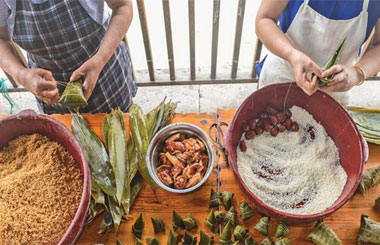An exhibition with immense cultural significance
Updated: 2016-06-09 07:43
By Lin Qi(China Daily)
|
|||||||||
The Precious Collection of the Stone Moat exhibition at the Palace Museum was undoubtedly a highlight of the 2015 cultural calendar.
The show, divided into two phases, displayed 283 classical Chinese paintings and calligraphy pieces once cataloged in the Precious Collection of the Stone Moat, an inventory of the royal collection of the Qing Dynasty (1644-1911). It was compiled under orders of Emperor Qianlong to record some 11,000 artworks that were considered excellent among his immense collection.
Most visitors had to wait for long hours to get a glimpse of the Qingming Shanghe Tu, one of the best-known pieces on display, which is a scroll that shows scenes along the river during the Qingming Festival.
However, because of the huge crowds, each visitor got only a few minutes to have a look at the painting whose colors have faded.
The exhibition is believed to have reignited people's interest in classical Chinese painting and calligraphy.
Over the years, there has been a growing interest in the Precious Collection of the Stone Moat among collectors of Chinese antiques.
Many items cataloged in the inventory were taken out of the Forbidden City (Palace Museum), and some even transported abroad, following the decline of the Qing Dynasty, social chaos, wars and other reasons.
Now, only about 1,200 pieces cataloged in the inventory remain at the Palace Museum.
Paintings and calligraphy scrolls listed in the catalog's three volumes are still sought after by potential buyers since the mainland art market started to boom in the 1990s.
In auction catalogs, a note saying "formally cataloged in the Precious Collection of the Stone Moat" is a strong indication of the work's authenticity and significance.
Another bible for collectors is the Catalog of Classical Chinese Paintings and Calligraphy compiled by a team of prominent connoisseurs, such as Xie Zhiliu, Qi Gong and Xu Bangda, in the early 1980s.
They examined hundreds of collections in both private hands and public institutions, and the catalog records their judgments, including their different opinions on the genuineness of particular works.
These catalogs are typically used when collectors need to identify a featured artist's other works.
|
The Precious Collection of the Stone Moat exhibition at the Palace Museum last year helps improve knowledge of classical Chinese painting and Emperor Qianlong's collecting philosophy. Photos Provided To China Daily |
(China Daily 06/09/2016 page6)
Today's Top News
China lists first sovereign offshore RMB bond on LSE
British PM denounces Brexit's 'complete untruths'
47% of European businesses would expand in China
Xi urges Washington to boost trust
Council of Europe unveils security convention
Former PM warns of chaos in case of Brexit
Basic income plan rejected by Swiss voters
Eyeing the goal in European football
Hot Topics
Lunar probe , China growth forecasts, Emission rules get tougher, China seen through 'colored lens', International board,
Editor's Picks

|

|

|

|

|

|








